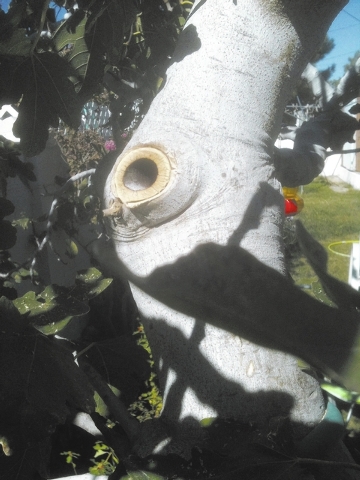Dethatch lawn now before it gets colder

Q: Is it too cold to dethatch my Bermuda grass lawn? Do I have to wait until next year? What about overseeding? Is it also too late? If I need to wait, then when?
A: It is not too late to dethatch in Las Vegas. Dethatching, sometimes called power raking or vertical mowing, is the removal of dead, grassy material that accumulates on the soil surface.
Bermuda grass is a warm-season grass and becomes dormant or turns brown when temperatures get cold. Bermuda grass produces a lot of this thatch, more than most grasses. If this thatch is not removed regularly, the appearance of a lawn will decline.
Thatch is removed when it accumulates to more than a half inch in thickness at the base of the grass.
Thatch does not accumulate by leaving the clippings lay on the lawn, provided you mow regularly. Nearly all lawn mowers now have a mulching feature to make mowing bagless. Returning the clippings to a lawn can substitute for one fertilizer application each year and does not contribute to thatch or any disease problems.
Years ago thatch was burned in the fall. In some rural areas it is still permitted.
In place of fire, we use machines that pull the thatch from the lawn. This thatchy material is then disposed in landfills rather than burned. The best time to dethatch is when the Bermuda grass is actively growing in the summer months or just before overseeding.
Overseeding is planting a new lawn of cool-season grass, such as ryegrass, in the fall just as Bermuda grass is becoming dormant. Thatch will interfere with the seeding of a winter lawn in Bermuda grass. Dethatching just before overseeding is commonly done for a better looking winter lawn.
Dethatching now won’t affect your Bermuda lawn but you are getting a bit late for the ideal time to overseed. As temperatures get lower, it takes longer for cool-season grass seed to germinate. The ideal time is mid-September through mid-October. Later than this can be a little chancy because we don’t know what the weather will do.
It is warmer in the city than in the suburbs so overseeding in the city is more successful later in the fall. As you get closer to the desert or higher in elevation, overseeding should be done earlier.
If you miss this time for dethatching, the next best time would be June, July and August.
Q: I have a fig tree that is close to 30 years old. I noticed some holes in the trunk, but as I am cutting the branches I find that some branches are completely hollow inside. The tree looks healthy and is putting out new growth, even from the hollow branches. Can you tell me what is causing this and if there is anything that I need, or can do about it?
A: Your pictures threw me for a loop. I have not seen that on fig before but I have seen something similar on other trees.
When trees grow, they grow two directions: upward and in girth. We know that upward growth is from the buds on trees. Growth in girth is not as obvious. Growth in girth is from some cylindrical layers just under the bark.
As a fig tree gets fatter, the center cylinder of the tree dies. As the tree continues to grow fatter and fatter, the dead wood in the center of the tree gets larger and larger. As long as the tree remains healthy and doesn’t get any infections, the dead wood in the center of the tree remains intact and solid.
On some occasions, organisms such as fungi and bacteria can invade the center of a tree and begin feeding on this dead wood. These organisms nearly always feed only on dead wood and not the living parts of the tree.
These organisms, technically, are not disease organisms but wood-rotting organisms. Since the center of a tree is dead, these organisms feed on this dead central cylinder.
This wood-rotting activity can hollow out a tree very effectively, leaving the outer living cylinder intact. I think we have all seen pictures or cartoons of animals living inside of trees. Well, this can actually happen.
The center of a fig tree is filled with dead wood that is soft and pithy. Once these wood-rotting organisms get going they will clean out that central core of the tree, the trunk and large branches. The living cylinder of the tree is healthy and unaffected.
You do not have a borer problem; it is a wood rotting problem. There is nothing you need to do about it. But, keep in mind that these branches may snap more easily than branches that do not have the central, dead core removed.
This is a reason I emphasize so strongly that pruning saws and shears be cleaned before you start pruning. It is best to clean and sanitize them between each tree, not necessarily between each cut unless you know a removed limb was diseased.
Bob Morris is a horticulture expert living in Las Vegas and professor emeritus for the University of Nevada. Visit his blog at xtremehorticulture.blogspot.com.


















